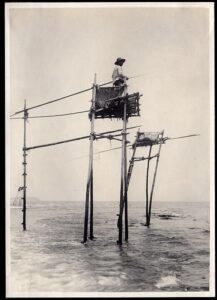Fishing and Bushido, in Kaga and Shonai
Have you heard the word Bushido? It stands for “the way of samurais,” literally, and it tells you about how samurais had to live their life as a soldier.
Interestingly, in one era, fishing was highly valued as a training program as a samurai soldier. In other words, fishing was considered to be a very important matter in Bushido, or on the path for the ultimate life of samurais.
In this article, I will briefly explain about Bushido, its history and show how it has been in the bottom of the heart of Japanese people. Then I will introduce one domain which took fishing seriously as one of the training for samurais, in the Edo period.
What is Bushido
Bushido is the compilation of lessons to become a better samurai. It teaches the importance of sacrifice, politeness, frugality, belief, honor and fighting. Actually there is no solid definition on Bushido, instead it is considered to be a collection of moral code of conduct, having been compiled with contents of oral teachings and writings of famous samurais.
While this Bushido is not formalized, it has been in the mind of samurai warriors. According to this book written by Inazo Nitobe, it is the chivalry, or similar to the noblesse oblige.
The origin of Bushido is in Buddhism, Shintoism and Confucianism. These are reflected onto modern Japanese people, unconsciously, for the values of common sense, ethical or moral views. Bushido is one of the instances of representing these values.
For example, Buddhism (Mahayana Buddhism) teaches us the importance of accepting the matters you cannot avoid or change, and moderate reliance on your fate. You can be calm when you face tragic events with this mentality. It is an important aspect for samurais, because they are likely to face such life-threatening incidents and need to behave calmly to take the best action. To realize it, they practice Zen,to reach above the thinking or human act through meditation.
In addition to this Buddhism value, Shintoism teaches the importance of being loyal, respecting the ancestors and the old. Similarly, Confucianism tells the ethical values of humanism, education, wisdom, knowledge, faithfulness, propriety and righteousness.
In summary, Bushido is the collection of the codes of conduct, which make the better warriors.
Bushido in practice
As explained, there has never been a certain textbook about Bushido. The practice is up to the hands of chiefs, or the leaders in a samurai group. In the Edo period, the practice or education of samurai was led by each domain. It means that each domain made the system to teach Bushido to their own samurais, to make their domain stronger.
Of course, programs to teach martial arts were a must in their educational system. What they need to reach is not just a level of good practitioner, but a level to survive when they see enemies. To achieve it, many domains employed Zen practices, and some used special activities such as paintings or music.
Interestingly, there were two domains that used fishing for their activity to realize Bushido. One was the Kaga domain and another was the Shonai domain.
Fishing in the Kaga domain
The Kaga domain was located in current Ishikawa prefecture and Toyama prefecture. This area has a rich nature, and fishing was a quite accessible activity for people. For this natural environment, this domain was one of the strongest domains in Japan then.
In this period, the country was dominated by the Edo government. For the government to take control, it limited the domain’s activity to train their own samurais, to make each domain weaker. In many domains, it was not allowed to have organized training of martial arts.
Kaga domain was one of such domains. While getting orders from the government, it thought of a way to train their soldiers covertly. Their solution was to use fishing to train their people. And it made this domain to have fishing for Ayu sweetfish as a subject which samurais had to master.
To catch this fish, you have to stand in the river for a long time. The domain considered that it is good to train samurais’ body, balancing ability, and being focused.
In modern Ayu fishing in this area, fishing with a live decoy fish is the most popular way. It is the way to catch fish who hold the territory, letting it attack the decoy fish with a hook. A fisherman controls the decoy fish to invade the territory and let the territory owner to attack. The attacker is to touch the hook attached to the decoy fish.
However in the Edo period, to use decoy was considered to be unfair in the Bushido. So they caught Ayu sweetfish with the flies. It is said that the fly fishing for Ayu sweetfish originated in this Kaga domain. And it left us the traditional craft of rod building and tradition of special fly patterns.
Fishing in the Shonai domain
The Shonai domain was located in the current Yamagata prefecture. There, it had a record that the chief of the domain enjoyed fishing in 1707, and his son was also in it. What tells us is that the son made the fish print of 39 cm of crucian carp. It is said to be the world’s first fish print. And this 8th chief of the domain encouraged people to do Iso fishing (fishing from rocky shore.)
The targets of their Iso fishing were black sea bream and cod, using rods called Shonai rods of up to 7 meters length. They needed to travel over the mountain. To start fishing at the best moment, the time of sunrise, they left their home before midnight, carrying the heavy fishing tackles including the long whip rod. I assumed that the way of fishing was drafting the hooked bait with chumming. The rod tip is connected to the main line, directly connecting the hook. The hooked shrimp was sent in the water with the cloud of shrimp chumming. The reaching distance was limited to the length of rod plus line. I assume they need to watch the water current well and be patient. To get the best result, sharp focus on the change of condition was needed. All of them must have been done after you had walked all the way to the spot with carrying tackles and baits on your shoulders.
I am sure that it was good training, physically and mentally.
Interestingly, when one could catch a big fish and report it with fish print, this person could get a reward from the domain. On the contrary, if they lose their rods, lose their swords, or die during their fishing, their payment (or payment to the family) have been reduced. We can see that it was a serious matter to go fishing then!
To read the Buddhist teaching “the importance of accepting the matters you cannot avoid or change and moderate reliance on your fate,” it reminds me of one nice description of fisherman mentality. All the anglers have to face the environment that they cannot change, and they have to accept it first, to think what to do with it, as a second step.
You keep going fishing, then you may get a mental state of samurais.


Thank you for sharing the unique perspective of linking Bushido to fishing. I can see the pursuit of fishing is indeed the strive for betterment in knowledge, techniques, and one's mental state. Glad that I run into your writings. I appreciate your great work.
Thank you for reading my blog! Fishing requires the total knowledge or the wholesome knowledge to approach your target fish. I will try to keep writing interesting articles, to entertain you further on!